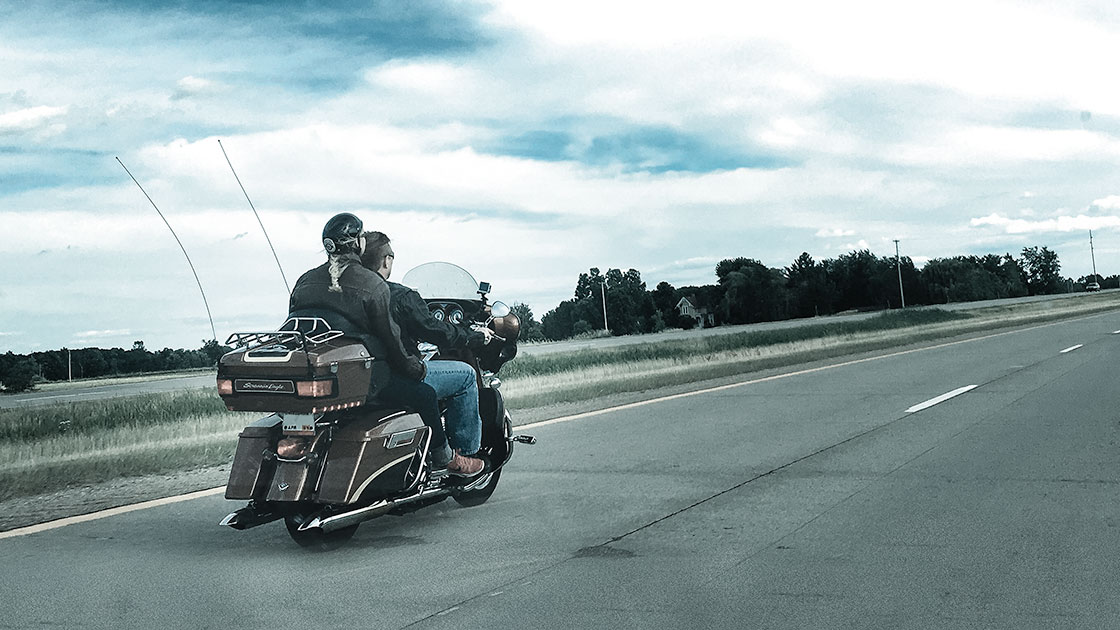Head injuries rise as riders ditch helmets in Michigan
September 1, 2016

Fewer riders in motorcycle crashes are wearing helmets, and trauma centers are seeing an increase in head injuries and a change in injury types following Michigan's partial repeal of its motorcycle helmet-use law, new research from the University of Michigan and IIHS indicates.
Michigan rolled back its helmet law to cover only riders younger than 21, effective April 2012. Motorcyclists 21 and older may ride without a helmet if they have either passed a motorcycle safety course or have held the motorcycle endorsement on their driver's license for at least two years. In addition, riders who choose not to wear helmets must have at least $20,000 in medical coverage.
IIHS, HLDI and other groups have been studying the effect of the law change, and, predictably, initial results haven't been positive. A 2013 analysis by HLDI found that the average insurance payment on a motorcycle injury claim rose substantially in Michigan after the state changed its helmet law to exempt most riders. The upshot of HLDI's analysis is that motorcyclist crash injuries have become more serious.
For a look at how the partial helmet law repeal has affected motorcyclist crash injuries and helmet use statewide, IIHS teamed up with researchers at the University of Michigan Injury Center, University of Michigan School of Medicine and University of Michigan Transportation Research Institute. Researchers analyzed police-reported motorcycle crash deaths and head-injury data from a statewide trauma registry 12 months before and after the law change. The study looked at both drivers and passengers and included 7,235 riders involved in crashes and 1,094 riders hospitalized at trauma centers.
Although there was no significant change in the motorcyclist fatality rate statewide, the fatality rate among unhelmeted motorcyclists in crashes across both time periods was nearly twice as high as the rate among helmeted riders (5.4 percent vs. 2.8 percent).
What is more, the percentage of hospitalized trauma patients with a head injury rose 14 percent in the post-repeal period. Doctors noted a shift in head injury patterns, too. The proportion of head injuries that were concussion-related fell 17 percent, while the proportion of head injuries due to skull fractures increased 38 percent. Trauma patients with head injuries were more likely to need costly hospital services, including intensive-care unit stays, ventilation and neurosurgical interventions than patients without head injuries.
The finding is in line with prior studies of the high costs of caring for motorcyclists with head injuries. A study of a single Michigan trauma center published in The American Journal of Surgery in 2016 found the average acute care cost of unhelmeted riders was nearly $28,000, 32 percent higher than for helmeted riders.
"Head injuries can have a devastating impact on the long-term health of motorcyclists and their families after a crash," says Dr. Patrick Carter, an emergency physician and injury researcher at the University of Michigan Injury Center and the lead author of the study. "The 14 percent increase in head injuries observed in our study is consistent with the negative public health impact we have witnessed following similar repeals in other states and should be considered as part of the policy debate regarding the importance of universal helmet laws for preventing injury."
Patients with head injuries were more likely to be intoxicated and less likely to be wearing a helmet. Alcohol-impaired riders in general are more likely to exceed speed limits, ride without a license and be involved in single-vehicle crashes. In 2014, 30 percent of fatally injured motorcycle drivers in the U.S. had a blood alcohol concentration (BAC) at or above 0.08 percent. In single-vehicle crashes, 43 percent of motorcycle drivers had 0.08 or higher BACs.
In a companion study, researchers estimated that three-quarters of motorcyclists statewide wore helmets following the law change, based on analysis of police-reported crashes in 2012-14 and a May-September 2014 roadside observational survey. That is down from 99 percent of helmet wearers observed in a 2006 statewide survey conducted by the Michigan Office of Traffic Safety Planning.
Still, the 75 percent estimated helmet-use rate in Michigan outstrips use rates in states with similar helmet laws. The authors point to the experience of Texas and Kentucky, where observed helmet-use rates dropped to about 65-66 percent from about 95-96 percent following the partial repeal of their helmet laws.
"The benefits of motorcycle helmets are well-established, so Michigan is fortunate that most riders are still wearing them. But the increase in serious head injuries among motorcyclists in crashes shows the dangers that come with repealing helmet-use laws," says Jessica Cicchino, IIHS vice president for research and a study co-author.
Boosting tourism is one rationale helmet law opponents cite for watering down or abolishing use laws, and there is some evidence that fatalities among out-of-state riders have increased in states following helmet-law changes. In Michigan, however, researchers didn't find any evidence that riders were traveling to the Great Lakes state to take advantage of cruising helmetless. Instead, 95 percent of motorcyclists involved in crashes were riding a bike registered in the state, about the same percentage as when helmets were required for all riders. That might be because the states that border Michigan already had lax helmet laws or none at all.
Michigan is one of 28 states with helmet laws covering only younger riders. Only 19 states and the District of Columbia require helmets for all riders.
The National Highway Traffic Safety Administration estimates that helmets cut the risk of a motorcycle fatality by 37 percent.